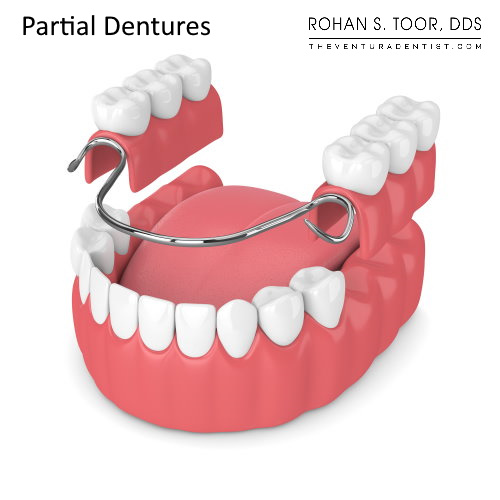 Partial dentures are removable dentures that replace two or more teeth in the upper or lower part of your mouth. They help you chew and bite again and make your smile look better. Partial dentures can be either removable or fixed. With a removable partial denture, you can put it on and take it off whenever you want. With a fixed partial denture, you never have to take it out of your mouth. Dr. Rohan Toor at Rohan Toor Dental Care has over 5 years of experience with dentures since 2017 and informs you what kind of partial dentures will work best for you.
Partial dentures are removable dentures that replace two or more teeth in the upper or lower part of your mouth. They help you chew and bite again and make your smile look better. Partial dentures can be either removable or fixed. With a removable partial denture, you can put it on and take it off whenever you want. With a fixed partial denture, you never have to take it out of your mouth. Dr. Rohan Toor at Rohan Toor Dental Care has over 5 years of experience with dentures since 2017 and informs you what kind of partial dentures will work best for you.
What are Partial Dentures?
A removable dental appliance called a partial denture has one or more false teeth that sit on a plastic or metal base that matches the color of the roof of your mouth. A partial denture replaces one or more missing teeth to make the mouth look and work better. One or more missing teeth can affect how the mouth works and looks. Partial dentures are also used for people who can't get a bridge because they don't have enough teeth to hold it up or can't afford it.
What are the types of Partial Dentures?
There are two types of partial dentures: fixed partial dentures and removable partial dentures. You may put and take a detachable partial denture out of your mouth as you wish. You cannot take out a fixed partial denture since it is fastened in your mouth.
What is an Removable Partial Dentures?
A gum-colored acrylic foundation and replacement teeth are the components of a detachable partial denture. It may be removed easily because it is not permanently cemented in your mouth cavity.
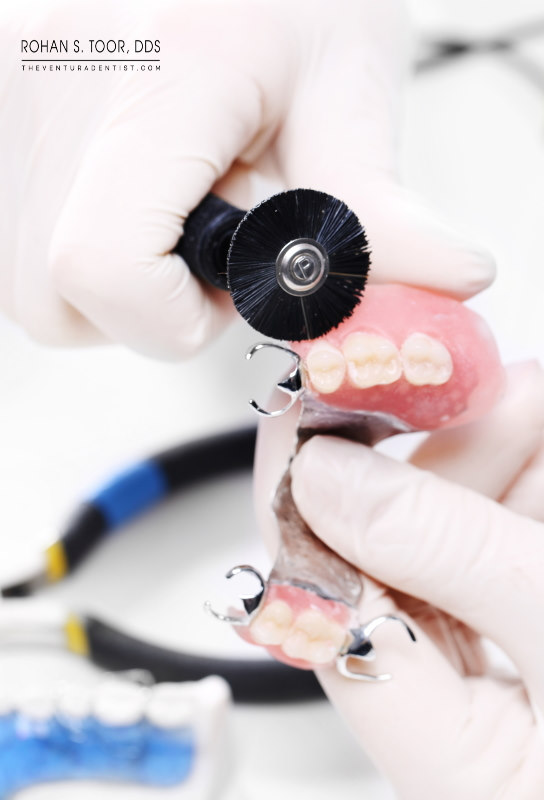
- Cast Metal Framework Partial Dentures. A cast metal framework for a removable partial denture supports replacement teeth of the best quality and uses precise attachments.
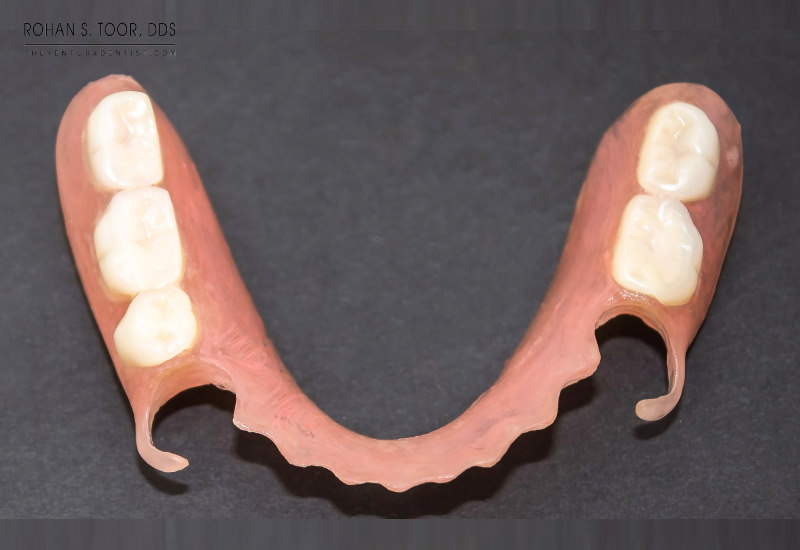
- Acrylic Clasp Partial Dentures. The least expensive partial denture is the acrylic clasp partial denture, which features detachable flippers. These should only be used temporarily since they lack aesthetic appeal and are challenging to wear. It employs acrylic clasps, which are less effective than cast metal.
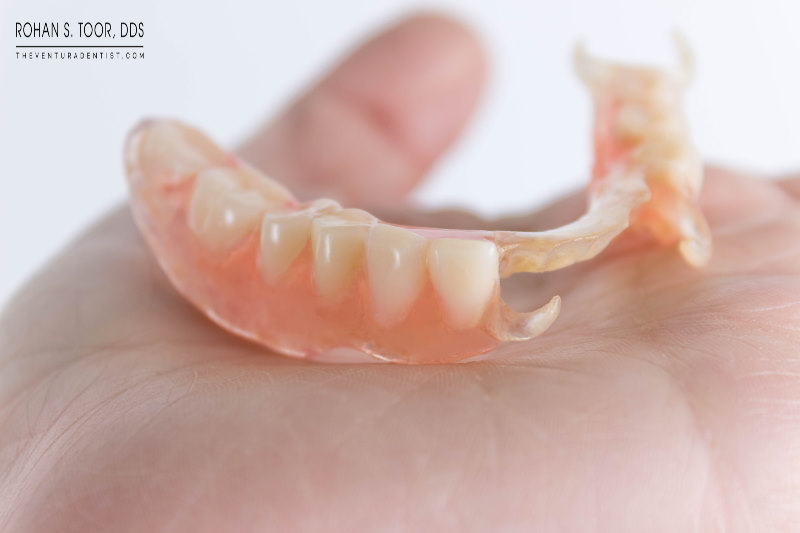
- Flexible Partial Denture. Since the clasps on a fixed partial denture are gum-colored rather than clear acrylic, they are less noticeable. For people who are allergic to acrylic, these are substitute options. Although flexible partial dentures are more costly than others, they are more comfortable than acrylic and aesthetically pleasing.
What is an Fixed Partial Dentures?
A row of artificial teeth is mechanically or fastened into place next to the actual teeth in fixed partial dentures, secured by Permanent Implants. Natural teeth or roots close to the area where lost teeth are to be replaced provide support for the fixed partial denture.
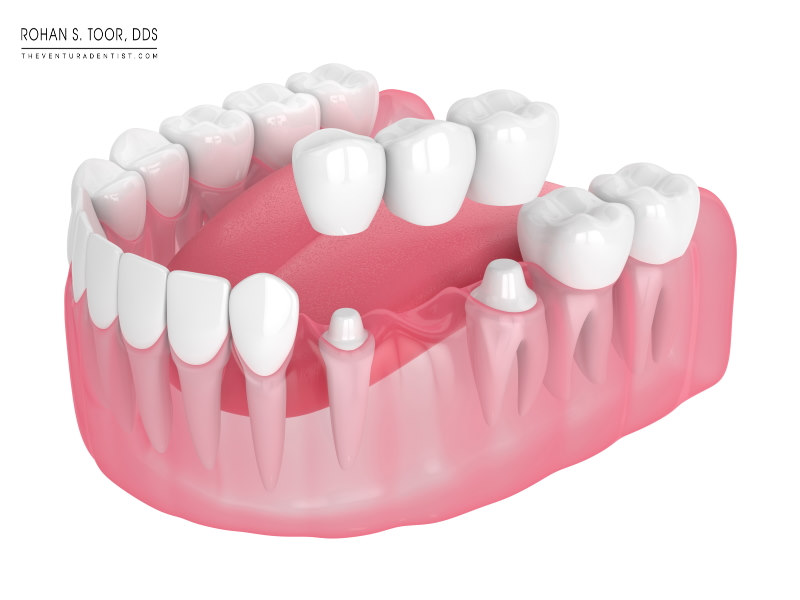
- Fixed Bridge. The neighboring teeth or dental implants are permanent anchors for a fixed bridge. The patient's adjacent teeth must be in good shape to file down and prepare the tooth so that the crowns can support it.
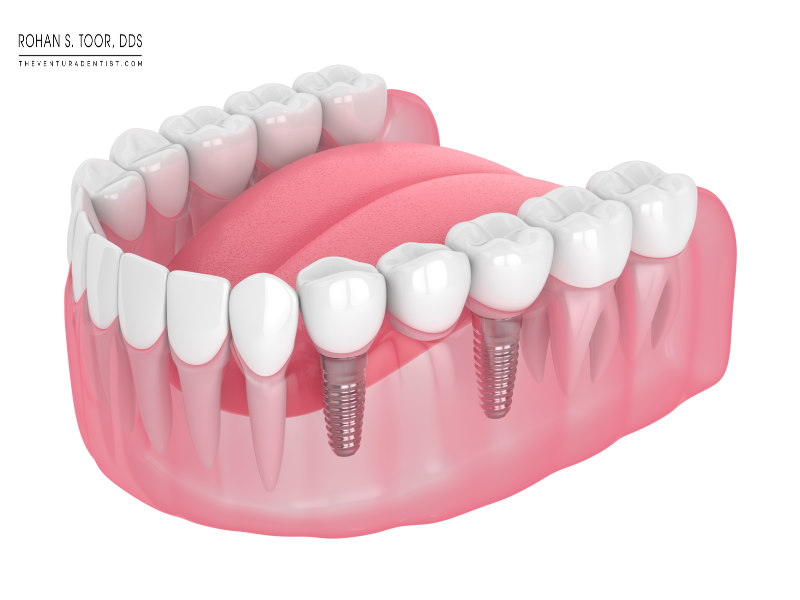
- Implant-supported Fixed Bridge. A fixed bridge supported by implants employs tiny, biocompatible titanium posts anchored permanently in your mouth. This kind of partial denture is advised for patients who lack neighboring teeth or would prefer not to harm their natural teeth.
How does Partial Dentures Process Work?
Since partial dentures are produced specifically for you, a process is followed to guarantee that yours fit, look, and operate perfectly. The following steps are commonly included in the partial dentures procedure.
- A dental examination. A dental exam is the first step in determining the state of your teeth and oral health. During the examination, our partial dentures dentist will search for any indications of illness, tooth decay, or prior dental work that could impact the fabrication of the dentures. Before attaching the dentures and withdrawing them, we'll also check for any teeth that could need to be extracted.
- Making dentures. After determining that you are an ideal candidate for partial dentures and that your gums have fully recovered, we will measure and mold your teeth to guarantee that your dentures fit perfectly. The lab that will construct the dentures according to specifications receives these measurements.
- Fitting the dentures. Once the dentures are finished, you will be summoned to our office for a fitting. You shouldn't feel discomfort or have any other problems when you wear it. Then, if required, we make changes to your dentures.
You'll need some time to become used to using your prosthesis. Once you've correctly adapted to your dentures, it will ultimately have the same function and control over your teeth. However, you may first experience some difficulties eating and speaking with it.
Make an Appointment with Dr. Rohan Toor at Rohan Toor Dental Care for Partial Dentures
* FREE Partial Dentures Consultation ($100 Value)
* FREE Digital X-rays, especially for Partial Dentures ($150 Value)
* We Maximize your Insurance, so you pay less out of pocket.
How long does it take to get Partial Dentures?
After tooth extraction, it takes six to eight weeks before partial dentures may be fitted. Every patient is different. Before receiving their dentures, some people must wait a few months, while others must wait a few weeks.
What are common problems with Partial Dentures?
Partial dentures might have issues, just like any other dental prosthesis. Some of the typical problems with partial dentures are listed below.
- Early on in the adjustment period, soreness and discomfort are normal. New dentures can contribute to discomfort by rubbing against your mouth and generating pain and irritation.
- It would be challenging to talk properly when getting acclimated to new dentures since they will feel unusual in the mouth.
- Because their mouths are still getting acclimated to the dentures or their gums are still mending, most patients find it challenging to eat regularly.
- Food particles quickly invade your partials, and bacteria are likely to grow there if they aren't cleansed right away.
Am I a Good Candidate for Partial Dentures?
For those who have lost a few teeth but not all of them, partial dentures are an option. Dentures might only sometimes be the best choice for patients, though. The people who are good candidates for complete dentures are listed below.
- Your teeth have been damaged, broken, or decayed way beyond repair.
- You have healthy gum tissue and jawbone.
- You have low self-confidence because of your missing teeth.
- You are not a good candidate for dental implants.
- You have difficulty chewing food.
How long do Partial Dentures Last?
According to the American Dental Association, partial dentures survive for 15 years. Your mouth and dentures may experience considerable changes throughout this period, affecting how well they fit and look. If you've been wearing dentures longer than recommended, ensure your dentist examines them.
What do Partial Dentures look like?
The plates of partial dentures include one or more fake teeth. A plastic or metal foundation that matches the color of the roof of your mouth holds it together. Clasps or precise attachments may be used to fasten the denture to the teeth. It resembles a retainer, but you do not have to remove your partial dentures to eat.
How much do Partial Dentures Cost?
The cost of partial dentures ranges from $1,400 to $1,800 depending on the kind, number of teeth, and location. The price also depends on whether parts of your teeth must be extracted or further procedures are required before the partial dentures can be placed.
How to care for Partial Dentures?
These actions can help your partial dentures last for many years.
- Before cleaning, fill the sink with water or lay down a soft towel to protect the object from breaking if it is dropped.
- After each meal, rinse your partial denture with warm water to eliminate plaque and food particles. Refrain from boiling or boiling water, as doing so will cause the partial to distort and compromise its fit.
- Brush your partial denture daily with a soft toothbrush or brush and denture paste; ordinary toothpaste is too abrasive and can damage the acrylic.
- Using denture-cleaning tablets, soak your partial dentures in water to remove minor stains and loosen plaque buildup.
- After soaking, clean your partial denture in warm water before reinserting it.
- Clean your partials every day to prevent the growth of bacteria.
What are the disadvantages of Partial Dentures?
The following are frequent disadvantages associated with partial dentures.
- It may take time to become accustomed to partial dentures.
- It performs less effectively than dental implants or bridges.
- It increases the likelihood of plaque formation around the abutment teeth and gum line, which can result in periodontal disease and tooth decay.
- Resting the dentures on your gums will exert pressure on your ridges and jawbone, resulting in gradual resorption.
FAQs for Partial Dentures
What are the best partial dentures to get?
There are many types of partial dentures at Rohan Toor Dental Care suitable for replacing missing teeth. Most patients feel that flexible partial dentures are superior to acrylic dentures because they are lighter, more flexible, and thinner.
Do partials damage teeth?
A removable partial denture can increase plaque buildup on the neighboring teeth, leading to cavities and gum disease if not properly maintained. Additionally, they cause damage to the abutment teeth because of frequent pressure or movement. However, appropriate cleaning and maintenance of the partial dentures prevent this.
Areas we Serve
Our office serves the following communities.